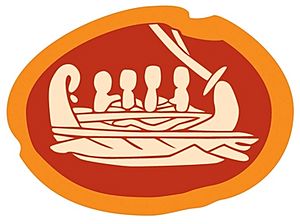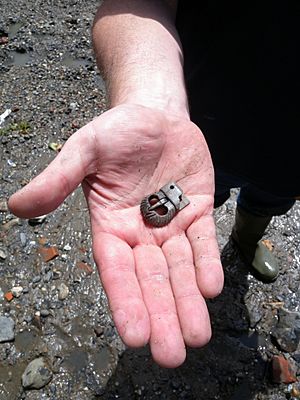Thames Discovery Programme facts for kids
 |
|
| Abbreviation | TDP |
|---|---|
| Formation | 2008 |
| Purpose | Promotion of the historic River Thames |
| Location |
|
The Thames Discovery Programme (TDP) is a special project that studies the history hidden along the River Thames in London. It's like a big detective team looking for clues from the past. The project started in October 2008. It helps people learn about the amazing history of the Thames.
A big part of the project is training volunteers. These volunteers are called the Foreshore Recording and Observation Group, or FROG. They help watch and record old things found on the riverbanks. This way, important historical sites are protected for the future.
The Thames Discovery Programme builds on earlier work by the Museum of London. Over three years, archaeologists from the programme explored 20 important sites. The FROG volunteers help keep an eye on these sites. They check for changes as the daily tides wash over the riverbanks.
The FROG volunteers learn how to record findings. They also learn about the history of the Thames and how to stay safe. The TDP team teaches them how to use digital tools for their work.
Today, the TDP has a small team of archaeologists. They work with the Museum of London Archaeology. There are about 150 active FROG volunteers. Many groups support the TDP, including the Museum of London and English Heritage.
Contents
Amazing Discoveries Along the Thames
The Thames Discovery Programme picked 20 key places along the River Thames to study. These sites were chosen based on earlier surveys. The first site they explored was Custom House in London. In 2009, FROG members recorded an old pathway there. They also found parts of an 1819 riverside wall.
They even found pieces of two old ships buried in the riverbank. Plus, they discovered a structure called a revetment. This was used to hold back the river.
In April 2009, the team looked at the river access at Isleworth. They recorded a boat slipway from the 1900s. They also found parts of a Victorian-era ferry pathway.
Shipwrecks and Ancient Structures
During low tides in June and July 2009, the team worked at Charlton. This area used to be a ship-breaking yard. They found very large ship timbers. These were the remains of one or more old warships.
Many old boat parts are found at this site. They also discovered a slipway made from old ship timbers. Plus, they found at least three smaller boats. In 2009, teams also worked at Alderman Stairs, Putney, and Bermondsey.
In November 2009, the FROG volunteers led a project at Carrara Wharf in Fulham. They recorded part of a bridge from 1729. Earlier that year, a TDP survey near Fulham Palace found Iron Age timber piles. These are very old wooden posts.
In January 2010, the team found a human skeleton on the Isle of Dogs. It dated back to the early 1700s.
In summer 2010, work continued on the Isle of Dogs. They recorded the slipways used to launch the famous ship SS Great Eastern. This was the last project of the engineer Isambard Kingdom Brunel. In July 2010, the TDP team and FROG worked near the Tower of London. They surveyed an area usually closed to the public. They recorded parts of the riverside wall.
The team also worked with "mudlarks" and the Portable Antiquities Scheme. Mudlarks are people who search for historical items in river mud. They recorded many artifacts found on the surface. The TDP team then moved to Greenwich. There, they examined the riverside wall again. They also found parts of a Tudor timber jetty and a new medieval structure.
In January 2011, the project shared exciting news about Vauxhall. They found the remains of the oldest structure in London. It dates back to the late Mesolithic period. This is a very ancient time!
During the summer of 2011, the TDP worked at Brentford. They recorded two old boats left on the riverbank. At Wapping, they surveyed a watermen's pathway and other boat remains. More fieldwork also happened at Greenwich and the Tower of London foreshore.
Public Events and Learning
The Thames Discovery Programme holds many events. These events help people learn about the river's archaeology and history. They offer public talks and small exhibitions. They also set up information stands.
You can join guided walks on the riverbanks. You can also watch FROG members working on site. There are special events for families and school groups. They also hold seminars and workshops.
The TDP has worked with many different groups. These include Fulham Palace, Historic Royal Palaces, and the Museum of London. They also worked with the Royal Society for the Protection of Birds at Rainham Marshes.
The project was even featured at the Museum of London. Thousands of people have visited the riverbanks and attended events. Many joined during the two-week Festival of British Archaeology each July. In 2009, the TDP celebrated the Festival at Fulham Palace. In 2010, the team was at the Tower of London and the Museum of London.
A detailed report about the project's work from 2008 to 2011 is on their website. In 2017, a book called The river’s tale: archaeology on the Thames foreshore in Greater London was published. It was written by Nathalie Cohen and Eliott Wragg.
Awards and Recognition
The TDP website won an award in 2010. It was for the "Best Representation of Archaeology in the Media." In February 2011, the project was nominated as "Best Research Project of 2011" by Current Archaeology magazine. In July 2012, the project won "Best Community Archaeology Project" at the British Archaeological Awards.
In 2013, Gustav Milne, who was the project director, was nominated as one of "Archaeologists of the Year." The Thames Discovery Programme also won the Archaeology Training Forum's Training Award. This award recognized their great work in training volunteers.
References
Invalid <references> tag; parameter "group" is allowed only. Use <references />, or <references group="..." />




